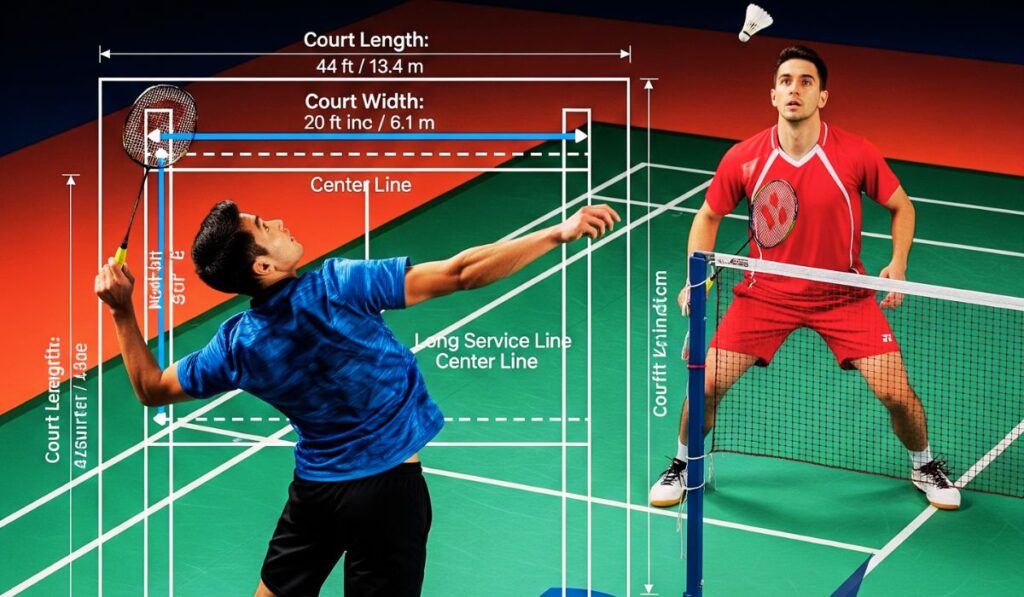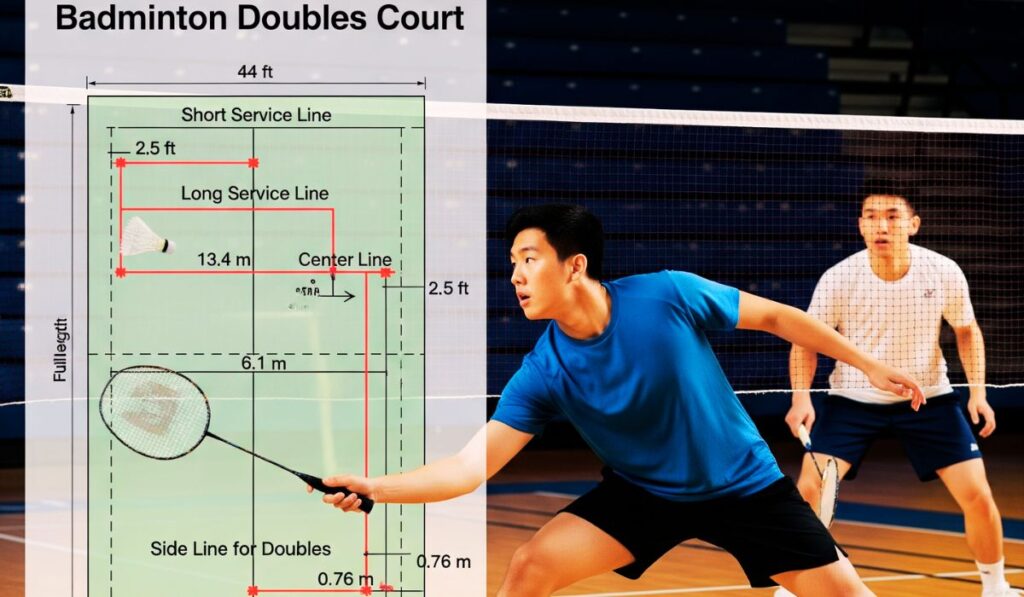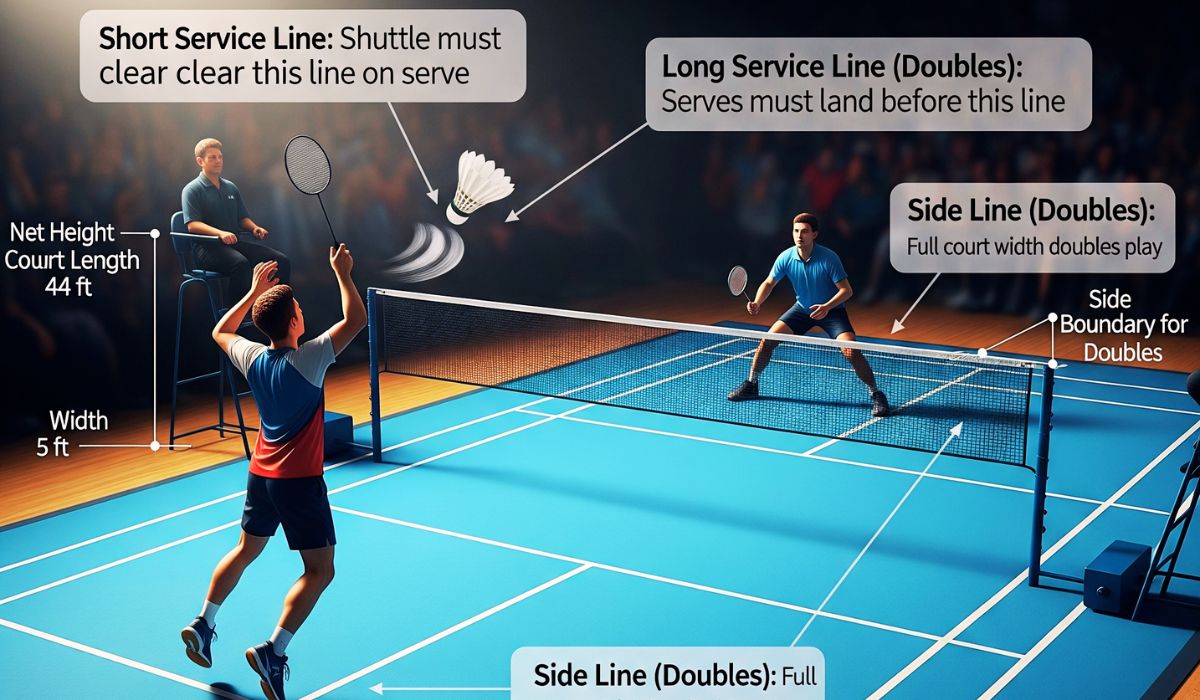Badminton Court Size Doubles: The Shocking Mistakes Players Make & The Secret Measurements Pros Swear By
There’s a reason why doubles badminton feels both thrilling and exhausting at the same time. It’s not just about the speed of the shuttle or the chemistry with your partner—it’s about the stage you’re playing on. The badminton court size for doubles is more than just a set of measurements; it’s the canvas where every smash, drop, and rally unfolds. And if you’ve been stepping onto the court without truly understanding its dimensions, you might be unknowingly sabotaging your own game.
In this detailed, human-written guide, we’ll go deep into the exact size of a doubles badminton court in feet, explore how it differs from singles, break down why each line matters, and uncover strategies that turn court knowledge into a competitive weapon. This isn’t just a technical breakdown—it’s a journey into the feel, rhythm, and strategic beauty of doubles play.
The Exact Doubles Badminton Court Size in Feet – No More Guessing
For doubles, the official badminton court size is 44 feet long and 20 feet wide. The length remains the same as in singles, but here’s the twist—doubles uses the full width of the court. That extra 2.5 feet on each side compared to singles might not sound like much, but in high-speed rallies, it’s the difference between winning and watching the shuttle drop helplessly just out of reach.
The lines are part of the Badminton court size doubles. So when that shuttle grazes the sideline and lands inside, it’s in—no debate. Understanding and visualizing this extra playing space is the first step toward mastering doubles positioning and defense.
The Sensory Experience of the Doubles Court
Step onto a Badminton court size doubles, and you instantly feel the difference. It’s wider, more open, almost daring you to take risks. The air feels faster because rallies cover more horizontal ground. You can almost hear the echo of shoes squeaking sharply as players dart to cover side smashes. This court doesn’t just demand skill—it demands connection, communication, and anticipation.
When your foot brushes that back boundary during a tense rally, you’re reminded that space is both your ally and your enemy. Doubles badminton is a dance, and the court is the ballroom floor.
Why Doubles Courts Are Wider – The Hidden Logic
The width of the badminton doubles court isn’t an accident—it’s designed to encourage more dynamic, team-based play. Wider courts push players to cover more lateral space, forcing quick side-to-side movement, sharper reflexes, and better coordination with a partner.
This added width creates thrilling angles. A well-placed cross-court smash can rip through even the tightest defense. The geometry of the court becomes part of the strategy.
The Difference Between Singles and Doubles Court Sizes
If you’ve ever played singles and switched to Badminton court size doubles, you’ll feel the change instantly. Singles courts are 44 feet long but only 17 feet wide. That 3-foot difference in width may seem small on paper, but it fundamentally changes gameplay.
In singles, the focus is endurance, depth, and controlling the center. In doubles, width is king—you have to guard the flanks without leaving the middle exposed. It’s a constant push-pull, and that’s what makes doubles electric.

Court Layout and Line Markings – Decoding the Map
A Badminton court size doubles has specific line markings:
- Sidelines for doubles: The outermost lines at 20 feet apart
- Back boundary lines: The end lines for both singles and doubles
- Service lines: Different in doubles; the long service line for doubles is 2.5 feet inside the back boundary
- Center line: Divides the service courts
These markings are more than paint—they dictate strategy, shot selection, and even mental pressure during rallies.
Serving in Doubles – Why Court Size Matters
The shorter long service line in Badminton court size doubles changes everything. You can’t just hit deep into the back court like in singles—serves must land between the front service line and that shorter back service line. This compresses the serving area, leading to more tactical, low, fast serves.
A deep understanding of where that service box lies can win you easy points before the rally even begins.
The Psychological Impact of Court Dimensions
Players often underestimate how much Badminton court size doubles affects their mental game. The wider doubles court feels more intimidating to cover, especially when facing aggressive opponents. But when you know exactly how much ground each side needs to protect, anxiety turns into anticipation.
A confident player doesn’t just react—they command the space.
Positioning and Rotation in Doubles
The badminton court size doubles setup encourages rotation between front and back or side-by-side formations. Knowing the exact boundaries helps you position yourself optimally, preventing gaps in coverage.
That moment when you glide perfectly into position to intercept a smash—without overstepping—is a direct result of court awareness.
Strategic Use of Angles
With the extra width, angled smashes and drop shots become deadly. You can stretch opponents beyond their comfort zone, forcing errors. The Badminton court size doubles isn’t just wider—it’s strategically richer.
How Court Size Shapes Rallies
Long rallies in Badminton court size doubles are often fast and flat, with shuttles zipping from sideline to sideline. Understanding the court’s proportions helps you anticipate patterns and respond quicker.
The knowledge that your opponent has to cover a wider space makes you braver in your shot choices.
Training for the Doubles Court
Drills for doubles often emphasize lateral movement, quick recovery, and short bursts of speed. Players who measure their footwork against the actual court dimensions during practice find themselves far more prepared in matches.
Common Mistakes Players Make About Court Size
One of the most frequent errors in Badminton court size doubles is misjudging the sidelines. Beginners often play too close to the center, leaving flanks exposed. Others stand too wide and get caught on flat drives down the middle.
Both mistakes are fixed by truly internalizing the court’s dimensions.
Badminton Court Size Doubles – International Standards
The dimensions mentioned here are per BWF (Badminton World Federation) regulations, used in all international tournaments. Whether you’re playing casually or competitively, sticking to these official sizes ensures consistency in your skills.
The Overlooked Truth About Badminton Court Size Doubles
Most players step onto a Badminton court size doubles without ever questioning its dimensions. They focus on the shuttle’s flight, the sound of strings meeting cork, and the rush of movement. Yet, hidden beneath the speed and sweat lies a silent game-changer: badminton court size doubles. Understanding these dimensions is not just about measurements—it’s about strategy, comfort, and unlocking your true potential in the game.
When you’re aware of every inch under your feet, you begin to move with purpose. You can anticipate the shuttle’s drop, defend aggressively, and attack with precision. And if you’ve been playing without knowing the exact Badminton court size doubles, you’ve been unknowingly handicapping yourself.
Exact Measurements That Define Badminton Doubles
In Badminton court size doubles, the court is a rectangle measuring 44 feet (13.4 meters) in length and 20 feet (6.1 meters) in width. This width is the first major difference from singles play—where the court is narrower. The extra side space in doubles transforms the rhythm of rallies and demands faster reactions.
The net is placed 5 feet (1.524 meters) high at the center, creating just enough of a challenge to test your smashes and drop shots. Each half of the court is split into a right and left service area, guiding where you can serve and receive. The service line for doubles is closer to the net than in singles, and this alone changes the dynamics of play dramatically.
Why The Extra Width Changes Everything
If you’ve ever played both singles and Badminton court size doubles, you’ve felt the difference. In doubles, the court’s 20-foot width demands constant side-to-side movement. Your eyes must track not just the shuttle but also the position of your partner.
The added space invites diagonal smashes, sharp cross-court drops, and clever drives. But it also opens the door for errors—especially if you misjudge the sidelines. One careless step, one inch over the line, and you’ve gifted your opponents a point. That’s why professional players obsess over court dimensions—it’s not just about where the shuttle goes, but where you can stand, pivot, and launch your next move.
Sensory Connection With the Court
Imagine stepping onto a fresh, polished badminton floor. The lines, painted in crisp white, almost glow under the lights. You feel the spring of the wooden surface beneath your shoes. Your mind instinctively measures the distance between the backline and net. You notice how the doubles side lines hug the edges like a tight frame around a masterpiece.
This sensory familiarity builds confidence. The more you feel the court, the more it becomes part of your instincts. Every stride you take is measured not in thought, but in muscle memory.
Singles vs Doubles: The Subtle But Crucial Differences
- Width: Doubles court is 20 feet wide; singles is 17 feet. That’s 3 feet of extra battlefield.
- Service Line: In doubles, the back service line is closer to the net, forcing shorter serves. In singles, it stretches to the baseline.
- Player Positioning: Doubles players guard half the court each, while singles players must cover it all.
- Shot Selection: Doubles favors flat, fast exchanges; singles rewards endurance and precise placement.
When you know these differences, you can adapt instantly if you switch between formats.
Impact of Size on Strategy
The badminton court size doubles plays directly into your tactical choices. For example:
- Attacking Play: The wider court allows deadly cross-court smashes.
- Defensive Stance: More space means you must tighten your formation with your partner.
- Serving Tactics: Short, low serves are essential to avoid being punished by a powerful return.
If you’ve been using singles strategies in doubles, you’re setting yourself up for frustration.
The Emotional High of Doubles
There’s an intoxicating rush when you and your partner control every inch of that 20-foot width. You hear the shuttle whistle past your opponents, see them scramble toward the sidelines, and feel the unity of perfectly coordinated movement. That shared victory in covering a larger space binds players together in a way singles never can.

Court Marking Rules You Can’t Ignore
- Sidelines for Doubles: Always the outermost lines.
- Back Boundary Lines: The same for singles and doubles.
- Short Service Line: 6 feet 6 inches (1.98 meters) from the net.
- Center Line: Divides each side into left and right service courts.
A player who ignores these markings ends up losing points on technicalities—a bitter way to go down.
Common Mistakes Players Make
- Stepping Out of Bounds: Misjudging the sidelines, especially on fast drives.
- Serving Too Deep: Hitting beyond the back service line in doubles.
- Poor Positioning: Leaving gaps in the court because of miscommunication.
- Not Adjusting Footwork: Using singles-style movement patterns in doubles play.
How Professionals Use the Court Size To Win
Watch any top-level doubles match, and you’ll see the magic. Players glide effortlessly, never overstepping, never crowding each other. They use the court’s full width to stretch opponents until a weak return sets up the kill shot.
Their success lies in perfect court awareness—knowing exactly how far they can push without losing control.
Training Drills To Master the Court
- Sideline Sprints: Improve lateral speed to cover the extra width.
- Service Accuracy Practice: Land 10 consecutive serves just inside the short service line.
- Shadow Footwork: Move as if rallying, without the shuttle, to engrain positioning.
- Two-on-Two Rotations: Practice switching sides seamlessly with your partner.
Why Knowing Court Size Makes You Mentally Stronger
Once you truly understand badminton court size doubles, you no longer fear the edges. Instead, you use them as weapons—placing shots just inches inside, forcing your opponents into awkward returns. This confidence radiates into every match, making you more composed under pressure.
Final Thought – The Court as a Weapon
Knowing the badminton court size doubles isn’t just trivia—it’s an invisible weapon. The player who understands every inch of that space gains a subtle, unshakable advantage.
When you walk onto the court and feel its exact width under your shoes, when you see its lines not as boundaries but as opportunities, you’re no longer just playing—you’re owning the game.

